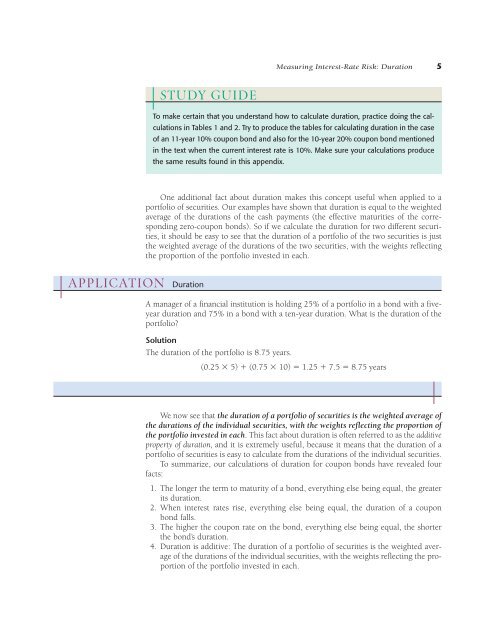Appendix to Chapter 4: Measuring Interest-Rate Risk: Duration
Appendix to Chapter 4: Measuring Interest-Rate Risk: Duration
Appendix to Chapter 4: Measuring Interest-Rate Risk: Duration
You also want an ePaper? Increase the reach of your titles
YUMPU automatically turns print PDFs into web optimized ePapers that Google loves.
<strong>Measuring</strong> <strong>Interest</strong>-<strong>Rate</strong> <strong>Risk</strong>: <strong>Duration</strong> 5<br />
STUDY GUIDE<br />
To make certain that you understand how <strong>to</strong> calculate duration, practice doing the calculations<br />
in Tables 1 and 2. Try <strong>to</strong> produce the tables for calculating duration in the case<br />
of an 11-year 10% coupon bond and also for the 10-year 20% coupon bond mentioned<br />
in the text when the current interest rate is 10%. Make sure your calculations produce<br />
the same results found in this appendix.<br />
One additional fact about duration makes this concept useful when applied <strong>to</strong> a<br />
portfolio of securities. Our examples have shown that duration is equal <strong>to</strong> the weighted<br />
average of the durations of the cash payments (the effective maturities of the corresponding<br />
zero-coupon bonds). So if we calculate the duration for two different securities,<br />
it should be easy <strong>to</strong> see that the duration of a portfolio of the two securities is just<br />
the weighted average of the durations of the two securities, with the weights reflecting<br />
the proportion of the portfolio invested in each.<br />
APPLICATION <strong>Duration</strong><br />
A manager of a financial institution is holding 25% of a portfolio in a bond with a fiveyear<br />
duration and 75% in a bond with a ten-year duration. What is the duration of the<br />
portfolio?<br />
Solution<br />
The duration of the portfolio is 8.75 years.<br />
(0.25 3 5) 1 (0.75 3 10) 5 1.25 1 7.5 5 8.75 years<br />
We now see that the duration of a portfolio of securities is the weighted average of<br />
the durations of the individual securities, with the weights reflecting the proportion of<br />
the portfolio invested in each. This fact about duration is often referred <strong>to</strong> as the additive<br />
property of duration, and it is extremely useful, because it means that the duration of a<br />
portfolio of securities is easy <strong>to</strong> calculate from the durations of the individual securities.<br />
To summarize, our calculations of duration for coupon bonds have revealed four<br />
facts:<br />
1. The longer the term <strong>to</strong> maturity of a bond, everything else being equal, the greater<br />
its duration.<br />
2. When interest rates rise, everything else being equal, the duration of a coupon<br />
bond falls.<br />
3. The higher the coupon rate on the bond, everything else being equal, the shorter<br />
the bond’s duration.<br />
4. <strong>Duration</strong> is additive: The duration of a portfolio of securities is the weighted average<br />
of the durations of the individual securities, with the weights reflecting the proportion<br />
of the portfolio invested in each.
















